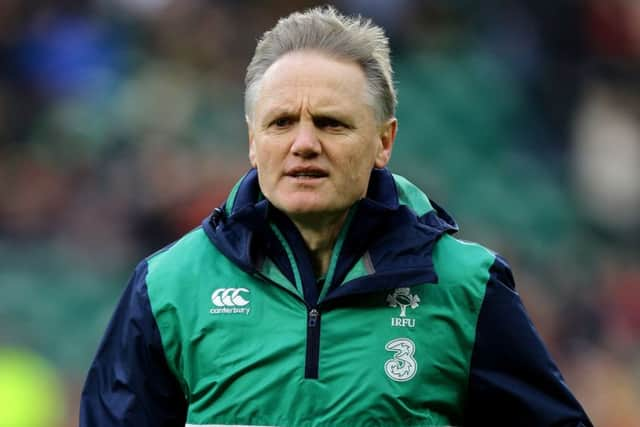Gareth Dyer's Rugby Union column


The Autumn International series began with a bang with Ireland providing the headlines.
They secured a superb victory over the previously invincible All Blacks in Chicago.
Advertisement
Hide AdAdvertisement
Hide AdThe Irish performance was a triumph in so many respects and a real shot in the arm for northern hemisphere rugby.


As a rugby purist it is always a pleasure to watch clever rugby minds in action, particularly when they are the difference between well matched sides in the final analysis.
To this end, the Irish tactical approach was a joy to behold. The Irish coaching staff developed a game plan to exploit the opposition, gave the players the confidence through preparation to execute it and then sat back and watched their team deliver it to the letter.
It was a triumph for clever thinking, for emphasising an approach centred on brains over brawn.
Advertisement
Hide AdAdvertisement
Hide AdThe phrase “getting your options from the opposition” appeared in Irish media before and after the game. I wasn’t aware that this was actually a philosophy of New Zealand coach Steve Hansen but had been borrowed by Ireland head coach Joe Schmidt and his coaching staff to prepare Ireland to make history with a first ever win over New Zealand.


No doubt you will have heard the phrase of playing “heads up” rugby which is a description of empowering players to make decisions during the game by spotting weaknesses and responding accordingly.
Clever players excel with this type of licence but in the northern hemisphere we have been obsessed for too long by gym culture – focusing more on developing the physical approach rather than the cerebral.
Thus whilst players in this part of the world have looked good on the beach, the quick thinking and depth of understanding displayed by the southern hemisphere sides has generally found their northern hemisphere counterparts wanting on the pitch.
Advertisement
Hide AdAdvertisement
Hide AdThus in the build-up to last Saturday’s game it was refreshing to hear that the Irish approach had focused on skill execution, positive tactical intent and designing set plays to exploit New Zealand weaknesses.
Sure there would have been defensive sessions and weights work but this didn’t dominate their preparation as has perhaps been the case in the past.
Ireland’s mental approach was to go toe to toe with the double world champions. After all, there would be no mileage in simply trying to slow New Zealand down and win by kicking a few penalties.
To beat the All Blacks, you have to score tries – and in the simplest terms – score more tries than they do.
Advertisement
Hide AdAdvertisement
Hide AdIt was clear from early in the game that Ireland would turn down kicks at goal to go for tries.
They wanted points on the board to apply score board pressure – something New Zealand had hitherto not experienced for a long time.
The Irish were not going to be naïve by passing up simple three point opportunities and nor were they going to ignore some of the more basic tactics in their quest for tries. The maul was their friend all match and was a simple identification of the All Blacks having a number of their main front five forwards missing.
However even in this area they brought subtlety to their play by varying the point of their maul attack and kidding the All Blacks into thinking the ball would be used in a different way.
Advertisement
Hide AdAdvertisement
Hide AdTo the uninitiated, Ireland’s maul set up varied slightly from attack to attack to change the direction of the drive. Different body positions and player positioning ensured no two mauls were set up with the same centre of drive.
That type of work doesn’t just happen by chance.
It was built on the training ground and was executed perfectly by players who had trusted in the approach and were able to maximise it to its full value in the game situation.
Other clever tactics exploited the individual weaknesses of several All Black players. The ability of the New Zealand midfield and wingers to make good defensive reads were fully stressed by putting numbers of green attacking shirts into their eye lines.
New Zealand wingers Savea and Naholo are beasts of men and virtually impossible to stop going forward. But they were found wanting positionally in defence, having to make split second decisions on where the threat lay and who to target.
Advertisement
Hide AdAdvertisement
Hide AdThe number of clean breaks by the Irish was testament to this being a successful tactic and highlighted that weaknesses do exist in this All Black team if you can create the relevant situations.
The Irish analysis work of the All Blacks was detailed and provided the clues as to how to win the game. But its delivery needed sharp minds, a disciplined approach and a desire to outwork the opposition. The Irish players had these attributes in spades.
After the World Cup, the stock of the Northern Hemisphere had never been lower.
Too slow, poor skill levels and a lack of game understanding were highlighted this time last year.
Advertisement
Hide AdAdvertisement
Hide AdHowever, with England in the summer and now Ireland in Chicago, this might just be a breakthrough autumn for the northern hemisphere if the standard of the Irish display last Saturday can be replicated by others over the coming weeks.
l I’m co-hosting the BBC Radio Lancashire monthly rugby program on Wednesday from 6-7pm, so please tune in!